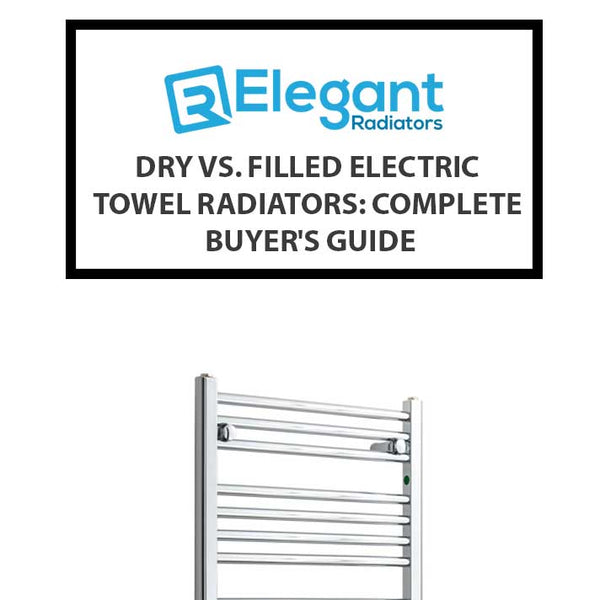Why Doesn't My Towel Rail Radiator Heat Up? Troubleshooting Guide

Why Doesn't My Towel Rail Radiator Heat Up?: Towel radiators are an exceptional addition to any bathroom and are commonly installed as an upgrade. These radiators are typically rectangular and taller than usual, but they are still radiators at the core!
Towel rail radiators, like all radiators, are prone to failure, but fortunately, most are simple to repair. Many potential solutions exist depending on whether the fault occurred in an existing towel radiator or a newly installed towel radiator.
Check if the radiator's valves at each end of a brand-new radiator are not heating correctly. One should lead in (the thermostatic or TRV valve), and one should lead out (the lockshield valve).
Ensure that the valves are not closed or are open enough. Additionally, some modern TRV valves are bi-directional, but it is still preferable to install them in the flow pipe leading to the radiator; to ensure that each valve is installed on the right side.
If the radiator is still not working, turn off the other radiators and observe whether it heats up on its own. If the cold radiator begins to warm up, this indicates an imbalance. Due to an imbalance, water in the system does not reach every radiator.
Problems that cause rail radiator not to heat up:
- Flow and balancing difficulties:
Home heating systems must distribute warm water to all radiators, but imbalances can occur. A problem with balancing may cause your towel radiator to heat slowly or not reach maximum temperature.
Turn off all radiators in your home except the problematic radiator; you will be able to identify a balancing issue if the problematic radiator continues to heat up properly in isolation from the other radiators.
- Blockage:
Radiators of a certain age can become clogged with sludge, limescale, and debris. This may cause only a portion of the radiator to heat up or prevent it from heating. Also, obstructions can form in the valves or pipes (though this is less common).
- Valves are sealed or frozen:
Check to see if the valves on each end of the radiator are sufficiently open. If you can confirm that the valves are open, the pin inside the valve may be stuck.
The valves may freeze if your heating has been turned off for a long time. Additionally, paint, dust, and debris can jam up the valve.
- How to bleed a bathroom radiator:
The majority of radiators should be bled annually. Bleeding is the process of releasing small amounts of excess air and water from the radiator.
Most radiator bleed valves are located in the top corner and can be opened with a bleed key or a screwdriver.
Solutions to radiator issues:
The majority of bathroom radiator issues should be relatively simple to resolve. On rare occasions, it can be necessary to unscrew the valves or examine the cold water feed in the attic, which might call for the help of a licensed heating professional technician.
- Rectify the system:
If your towel radiator heats up slowly or does not reach the desired temperature, try turning off your other radiators to observe how the problematic radiator heats up in isolation. If it heats up successfully, you should attempt to rebalance the system.
Rebalancing is a time-consuming process because you must adjust all radiators sequentially.
- Remove the obstruction:
Blockages, including the radiator's valve, plumbing, and the radiator itself, can form anywhere.
Consider flushing the radiator if the top of the radiator is heating well, but the bottom is not. You can perform a DIY flush, but you should only consider a more thorough flush upon the recommendation of a heating technician.
You can also disassemble the valves to determine if they are clogged with sludge; however, you should turn off the water supply first.
- To repair closed or frozen valves:
If your towel radiator is newly installed or if you have recently adjusted the valve settings, ensure that the valves are fully open. If the valves appear normal from the outside, they may have frozen internally. Then follow the steps below:
- Remove the valve head to expose the valve pin to repair stuck valves.
- To make the valve pin more flexible between the open and closed positions, use the flat side of a screwdriver.
- Ensure the valve head is reinstalled correctly to align with the current settings.
- Pipetting the radiator:
Radiator bleeding is quick and straightforward and should be your first course of action for common radiator issues.
First, deactivate the heating system and allow the radiator to cool. Locate the bleed valve (typically in the top corner of the radiator - there might be one or two).
Gradually loosen the valve with a bleed key or screwdriver until you hear air rushing out (some water might leak out, too, so place a towel on the floor if needed).
Once the radiator ceases to release air (not water), close the valve securely.
Be wary of valves that won't open because they're clogged with paint; you may need to remove some of the paint to open them carefully.
If too much water escapes during the bleed process, you may need to replenish the system to achieve adequate pressure.
FAQs:
What purpose do the two valves serve on a towel radiator?
The towel radiator's valves regulate the water flow through the pipes. This guarantees that your radiator will heat effectively and efficiently. They maintain the functionality of your towel radiator and ensure that your bathroom is heated as needed and that your towels are dry and ready for use.
Do radiator valves need to be fully open?
Additionally, it would be best if you fully opened the TRVs (thermostatic radiator valves). While you can manually operate thermostatic and wheel head valves, lockshield valves require a specialized tool or an adjustable spanner.







